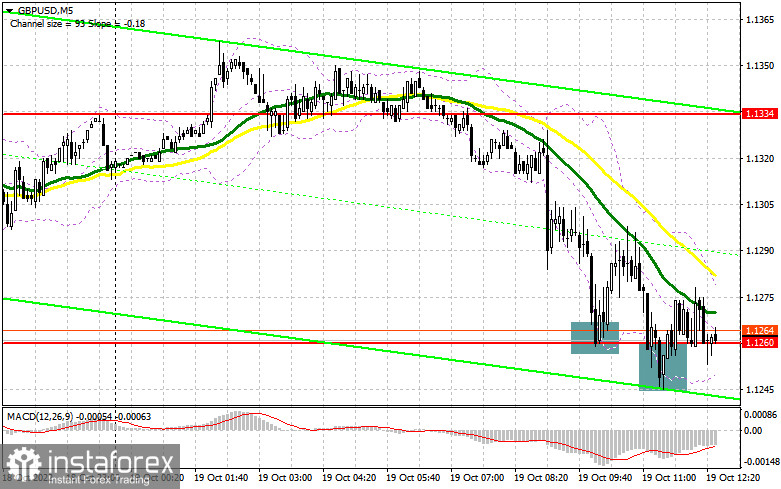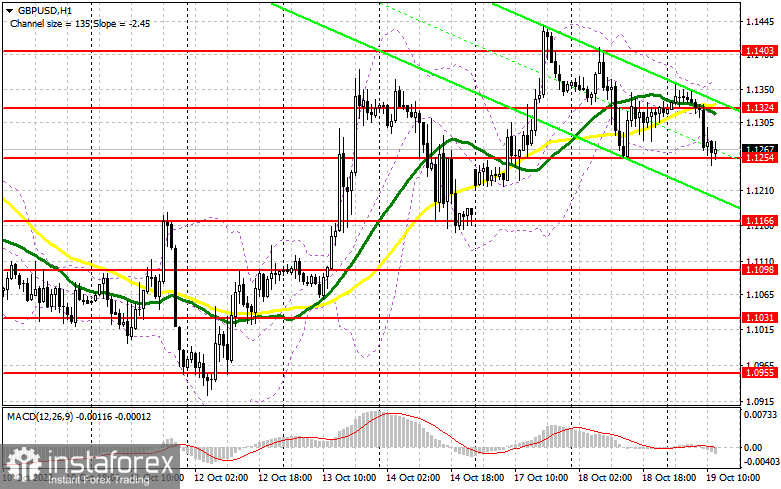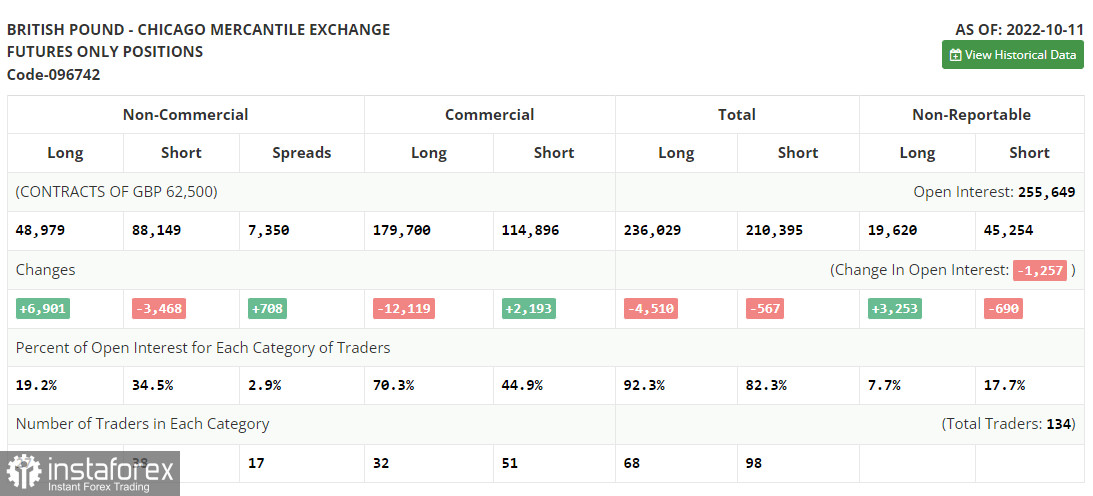In my morning forecast, I paid attention to the 1.1260 level and recommended deciding on entering the market there. Let's look at the 5-minute chart and figure out what happened. The decline and false breakdown in this range after the release of the next data on inflation in the UK, which recorded its next jump, led to an excellent buy signal, but after moving up by 35 points, the pressure on the pound returned, and we quickly slipped back to 1.1260. The bulls managed to defend this level on the second attempt, but the technical picture for the American session was slightly revised.

To open long positions on GBP/USD, you need the following:
While trading is above 1.1260, we can count on further pound recovery after a fairly significant correction. A lot will now depend on data on the real estate market in the United States, which may begin to buckle under pressure from high-interest rates and an economy sliding into recession. Reports are expected on the volume of construction permits issued and the number of new foundations laid. In the case of another decline in the pair after strong statistics, only the formation of a false breakdown in the area of the new support of 1.1254, by analogy with what I discussed above, will allow you to enter long positions in the expectation of continuing to build a bull market. Just below 1.1254, the lower border of the ascending channel passes, so you can try to pull the maximum out of this level. The target of the movement will be the 1.1324 area – a new resistance formed by the results of the first half of the day, where the moving averages are already playing on the bears' side. A breakout and a top-down test of 1.1324 will create a direct road to the area of 1.1403, strengthening the bull market. Going beyond this level will allow you to test 1.1488, where I recommend fixing the profits. Under the scenario of the GBP/USD falling against the background of strong statistics and hawkish comments by FOMC member Neil Kashkari, as well as the absence of buyers at 1.1254, the pressure on the pound will increase. In this case, I recommend postponing long positions to 1.1166. I advise you to buy there only on a false breakdown. It is possible to open long positions on GBP/USD immediately for a rebound from 1.1098 or in the minimum of 1.1031 with the aim of correction of 30–35 points within a day.
To open short positions on GBP/USD, you need the following:
The bears did everything possible to regain market control and succeeded again. However, as yesterday, the problems began already in the area of 1.1254, on which they will now be focused. In the event of weak data on the real estate market in the United States, and most likely will happen, the optimal scenario for sale will be a false breakdown in the resistance area of 1.1324. This will strengthen the upper boundary of the new descending channel, and the target, in this case, will be the nearest support of 1.1254. Only a breakthrough and a reverse test from the bottom up of this range will give a good entry point with an exit to the minimum of 1.1166, for which buyers will again begin to fight actively. The furthest goal will be the 1.1098 area, where I recommend fixing the profits. With the option of GBP/USD growth and the absence of bears at 1.1324 during the American session, bulls will continue to return to the market in the hope of leveling the situation and updating monthly highs. This should push the pair to the area of 1.1403. Only a false breakout at this level will give an entry point into short positions with the aim of a new downward movement. In case of a lack of activity there, I advise you to sell GBP/USD immediately for a rebound from 1.1488, counting on the pair's rebound down by 30-35 points within a day.

The COT report (Commitment of Traders) for October 11 recorded a sharp reduction in short positions and an increase in long ones. The intervention of the Bank of England has influenced many traders who are now betting on the strengthening of the pound in the medium term. More recently, it became known that the regulator had decided to temporarily suspend its quantitative tightening program, better known as QT. This is to help the bond market recover a little after the sharp collapse that occurred due to the actions of British Prime Minister Liz Truss. However, one should not count on a sharp rise in the pound in the medium term, as the economy's recession and aggressive policy on the part of the Federal Reserve System are ahead, making the US dollar more attractive. The latest COT report indicates that long non-commercial positions increased by 6,901 to 48,979. In contrast, short non-commercial positions decreased by 3,468 to the level of 88,149, which led to a slight reduction in the negative value of the non-commercial net position to -39,170 versus -49,539. The weekly closing price dropped to 1.1036 against 1.1494.

Indicator signals:
Moving Averages
Trading is below the 30 and 50-day moving averages, which indicates a return of pressure on the pound.
Note. The period and prices of moving averages are considered by the author on the hourly chart H1 and differ from the general definition of the classic daily moving averages on the daily chart D1.
Bollinger Bands
In the case of growth, the upper limit of the indicator around 1.1370 will act as resistance.
Description of indicators
- Moving average (moving average determines the current trend by smoothing out volatility and noise). Period 50. The graph is marked in yellow.
- Moving average (moving average determines the current trend by smoothing out volatility and noise). Period 30. The graph is marked in green.
- MACD indicator (Moving Average Convergence / Divergence - moving average convergence/divergence) Fast EMA period 12. Slow EMA period 26. SMA period 9
- Bollinger Bands (Bollinger Bands). Period 20
- Non-profit speculative traders, such as individual traders, hedge funds, and large institutions, use the futures market for speculative purposes and to meet certain requirements.
- Long non-commercial positions represent the total long open position of non-commercial traders.
- Short non-commercial positions represent the total short open position of non-commercial traders.
- Total non-commercial net position is the difference between the short and long positions of non-commercial traders.





















